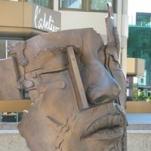Leaderboard
Popular Content
Showing content with the highest reputation on 12/23/2019 in all areas
-
Not bad at all. There's a few things I can point out: 1) Keep the instruments grouped together. Oboe, Bassoon, and Contrabassoon should all be within one system above the strings. This is just traditional practice -and most people are taught to read scores this way. 2) Is all this meant to be legato? No slurs? No staccato? 3) My final thought is about voice leading and contrapuntal lines. I notice quite a few instances of all voices moving in the same direction -or where one voice goes contrary. I'd look at beefing this up a little bit -just to provide more lushness and interest. 4) You use a lot of key changes in this piece -and then seem to abandon the key signature altogether after only a few bars within that key. I'd lobby for just doing away with key signatures altogether and just use the appropriate accidentals. Might make a bit more sense. Other than that, I like that you stick to a brevity of thematic material. Nicely done.1 point
-
@Hughes Thank you so much for the detailed review! I'm glad you like it, I've been thinking about a darker second part in a long time, I just don't find the time or inspiration for this piece. About your harp and other quiet instruments- sometimes I gave them place (say to the Eng horn after the first main theme), sometimes I put them there for a more complex, detailed, texture. I highly enjoy listening to music with tiny voices running around in the background for a more complete texture. The harp is not heard because I believe that's just how loud it would get. Guess I should ask the others to play more quietly so the listeners would be able to hear it sometimes. Maybe I'll give it more important parts in the second part, at the moment it's there for gentle touches of grace once in a while. Thanks again for the detailed review! I haven't got such a good review in... I think a year? I'll upload the next part once I make it but that might take a long time...1 point
-
I don't have answers for all these questions but here are my thoughts. I definitely don't think it's a dog's breakfast. To me, there isn't actually too much going on at once. If I can wrap my head around it without getting tangled, then it's not too much. I liked that little bit in the violin and viola at measure 260. I think it appeared more than once but I wasn't following the score the whole time and I kept replaying sections that I liked so I kind of lost track. The main theme grew on me pretty quickly and the whole thing didn't seem to meander too much, so in my book that's good work!1 point
-
Sounds cool! I hope you're planning on posting the finished product for us to hear once you're done!1 point
-
Not very sure how to respond to this. I’ll try but if you disagree please disregard these comments. It is your work after all. I couldn’t quite understand the key signatures changing each bar at the opening. And in bar 4, why the B natural rather than C flat of the key signature (ok, if strings as the fingering would probably be different or harpists who are used to weird looking chords). The marimba may not sound out, the way you’ve arranged the dynamics – f on the piano, p dimming to pp on the marimba (bar 8 on). When you get to the fff (bar 35) the bass holding an independent line, the texture sounds muddy. This may be the effect you want, if so please disregard. (You’re right about the choir not being much use here if singing mp against fff.) When you use the Basses for accentuation (bar 90 onward) it’s a lot easier to listen to. I suggest a change in arrangement of the piano part, here and elsewhere. Unless you have Lisztian hands the left hand stretches are impossible. Ok, you’d play the top E flat with the right thumb but it may look better to put it on the treble staff, stem down, to show it or say something in text on the score. I listened out for the locrian mode but couldn’t detect it – possibly because, well, you pinpointed its cadence problems base triad/final has no 5th, “dominant” is a diminished 5th. You may have modulated out of it quickly on occasions you used it. I know of these problems having written a symphonic piece for strings in this mode and it gets hopelessly boring unless modulating frequently (and adding 7ths 9ths and 11ths to the basic triad). Well done on composing a fairly long piece. It comes across to me in the semi-minimalist style (if there is such a thing) of Nyman.1 point
-
I agree that the syncopation is not an issue, and Quinn cites a good example. It's mainly the counterpoint in the a' sections of every phrase once the percussion comes in that kind of clash that may be the reason you think it might sound a little off. It's not bad, and you don't even have to change it, it's just that audiences (including yourself) will hear those lines as a fluid line jumping in register because of the quick pace. You could even rhythmically highlight that! Nothing wrong with that, just something to be aware of.1 point
-
Not at all. If you mean by 'a bit off' do they always come where expected?' then it's no, here and there but you know what? It keeps well in touch with its basic rhythm and the syncopation only adds interest. Have a listen to the Rite of Spring.1 point
-
It is a long time since I was last on this site, and I have missed hearing your compositions. It was a delight, therefore to find this fragment. I have listened to it half a dozen times, each time hearing it more clearly. I have also looked over the score, although I do not have perfect pitch so I am unable to 'hear' music this way. First, the piece is exactly as you entitle it: a call to adventure. Having watched a great many action and adventure movies, your piece fits the genre perfectly. Well done. I was not reminded of The Shire, despite having watched The Hobbit and The Lord of the Rings trilogies many times. If pushed I would say that there was the very mildest of resemblances to the Pirates of the Caribbean theme, but less Irish and more English, somehow. I am more reminded of the Westerns I used to watch many years ago as a child. So, I do not believe you have any reason to be anxious that your composition is specifically derivative. Second, on first listen, there were several places where the simple rhythm got a bit lost. On listening more I could hear that, in fact, something more complex was going on, as I would expect of serious music. However, in my stereotyping of the genre, I would say that the simple rhythm needs to be obvious, although not necessarily forefronted, throughout any 'A' sections. In contrast to what I have just written, were I listening to Sibelius, I would expect to hear simple rhythms become increasingly complex, which is ultimately more interesting. Third, on listens after my first, I was very keen for the piece to continue. Specifically, I was looking towards a somewhat darker 'B' section (perhaps then followed by a return to the 'A' theme). Fourth, try as could, I was unable to hear the harp. From the score I knew the harp was playing, and I was looking forward to the glissandi, but I just could not hear them. Fifth, and following on from four, I am going to be very bold, inasmuch I am sure that many others on this site are able to advise you better that I ever could. I think that if you want phrases on specific instruments to be heard, then you need to make holes in which that can happen. In my limited experience, this seems to apply especially to the quieter instruments. I did hear the xylophone, albeit only once, towards the end of the piece. Of course, the other obvious way to handle this would be to include several harps, etc., so as to increase their sound volume in relation to the other, louder instruments. Sixth, I liked the balance you brought between passages in which multiple threads were being pursued, passages that were harmonious with the theme/melody, and passages that were unison, emphasising the theme/melody. That balance, it seems to me, fits well with the genre. Orchestral music is usually my preferred musical environment. I am, therefore, excited that you are interested in adapting your talents to include orchestral music. I look forward to hearing where you might take this piece, should you develop it further, and to future orchestral pieces you might compose.1 point
-
I love your harmonic language here. The piece definitely has a Yiddish feel to it -which I adore. A few comments: 1. I love how the Viola counterpoint comes from nowhere at measure 13 (one of my favorite techniques). However, the double stops at measure 18 bring attention to this line and pull it to the foreground -which I don't think was your intent. I'd look at redoing this. 2. The extended techniques used add nice color. I loathe reviewing pieces that use harmonics, beating on the instrument, and other techniques arbitrarily. You use them to add timbral variation -and you do it well. All in all, I greatly enjoyed this piece! Thanks very much for sharing. I look forward to hearing more of your work!1 point




